标签 智利 下的文章
马可罗尼企鹅,德雷克海峡,智利 Macaroni penguins, Drake Passage, Chile (© Paul Souders/Getty Images)
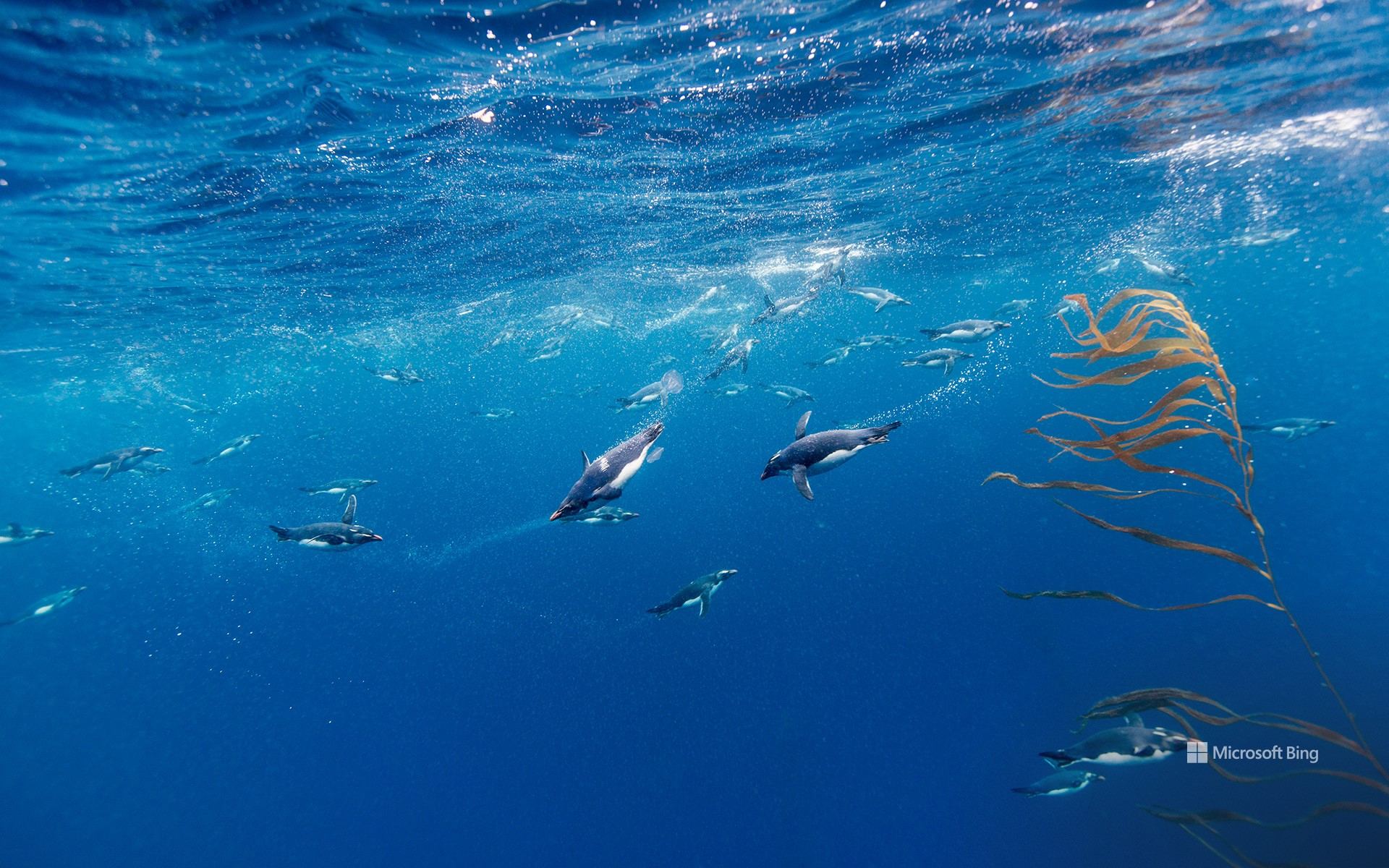
马可罗尼企鹅,德雷克海峡,智利 Macaroni penguins, Drake Passage, Chile (© Paul Souders/Getty Images)
冰雪极地的马可罗尼企鹅 Macaroni and freeze
企鹅意识日
让我们行动起来,一起投入到企鹅意识日的活动中去吧!你能说出多少种企鹅的名字?今天的照片展示的是敏捷的马可罗尼企鹅在智利德雷克海峡浮游生物丰富的水域中畅游的场景。这些迷人的生物只是在南半球发现的18种企鹅中的一种,可以通过它们奇特的橘色装饰性羽毛和突出的橙色喙来识别。马可罗尼企鹅成群结队地觅食,但雄性企鹅之间会相互攻击。为了表现出和气和避免打斗,个体通常会把头缩在胸前,这样就可以轻松地穿过企鹅群。尽管企鹅深受人类的喜爱,但近年来食物的减少、渔网的误捕,以及气候变化对其栖息地海冰的深刻影响,都对企鹅的生存构成不小威胁。
Penguin Awareness Day
Let's flap our flippers and dive into Penguin Awareness Day! Today's image features macaroni penguins swimming in the plankton-rich waters of the Drake Passage off the coast of Chile. These charming creatures, one of 18 different species of penguin in the Southern Hemisphere, can be recognized by their flashy amber crests and orange beaks. The name is said to have been coined by English sailors, derived from a term used to describe flamboyant dressers in the late 18th century.
Macaroni penguins can be a bad-tempered bunch who get into noisy fights. To avoid this, males often ease their way through crowded colonies with their heads tucked down to their chests. The main threats though, are not their fellow penguins. Reduced food availability, fishing nets, and the impact of climate change on sea ice are among challenges faced by this species, which has been classified as vulnerable due to population decline.
佩霍湖,百内国家公园,智利南部 Lake Pehoé, Torres del Paine National Park, Chile (© OST/Getty Images)
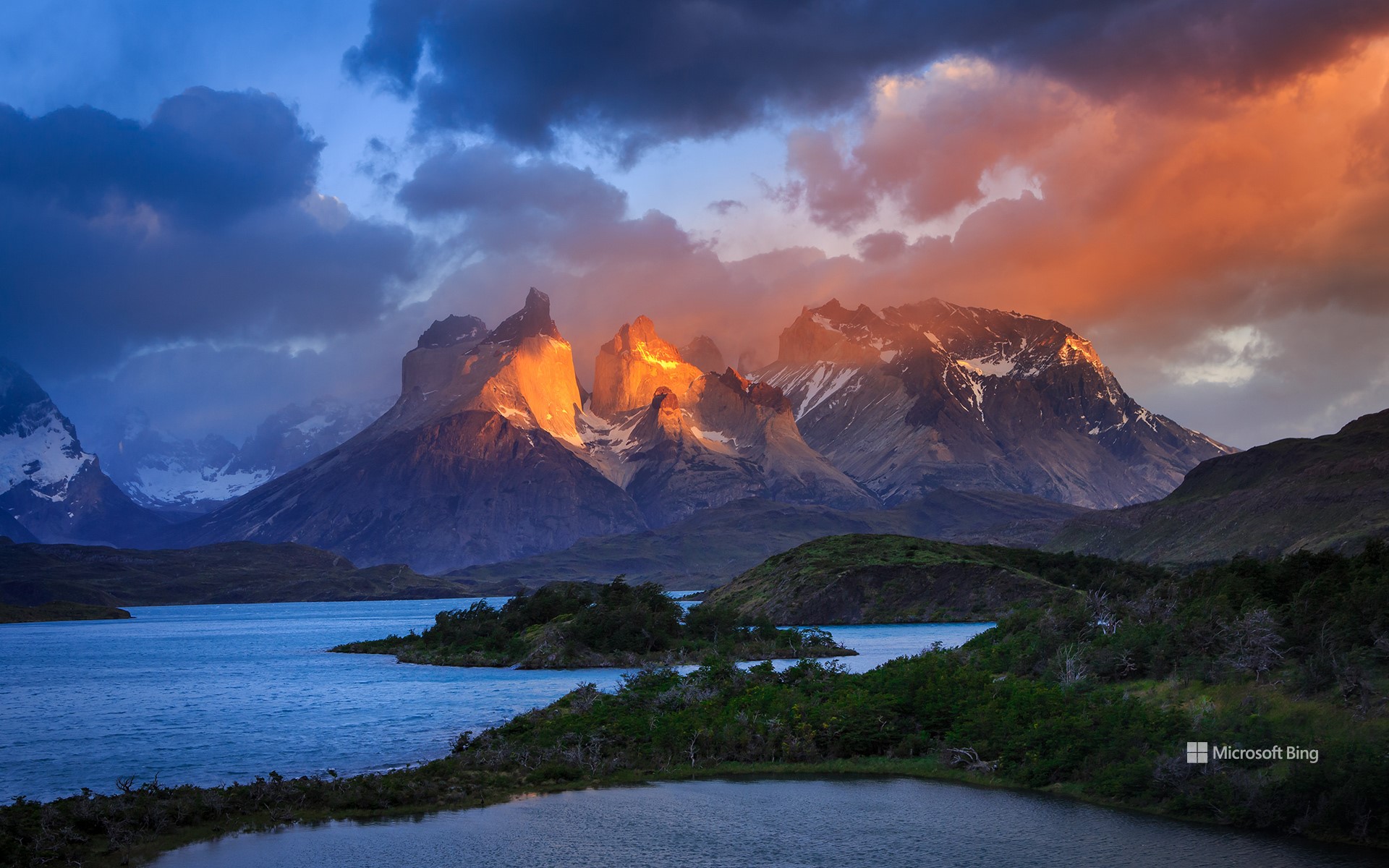
佩霍湖,百内国家公园,智利南部 Lake Pehoé, Torres del Paine National Park, Chile (© OST/Getty Images)
照亮你忧郁的心 Shine a light into your blues
佩霍湖,百内国家公园,智利南部
蓝绿色的湖面上倒映着蔚蓝的天空,周围是嶙峋的山峰和郁郁葱葱的森林,这就是佩霍湖。这个冰川湖坐落在智利南部的百内国家公园内,是大自然的杰作。佩霍湖周围那高耸入云的百内犄角山(因形状酷似牛角而得名)和百内山丘也是一道特别的风景线。佩霍湖的湖水呈现出独特的绿松石蓝,是因为水中悬浮着被称为冰川粉或岩粉的细小岩石颗粒和矿物质。据说“Paine”(百内)一词源于特维尔切语,意为“蓝色”。1978年,百内国家公园被联合国教科文组织认定为生物圈保护区,其面积达700平方英里。徒步、划船、观星……公园里有许多精彩的游玩项目,带上你的冒险精神,向南出发,来一段“告别忧郁”之旅吧!
Lake Pehoé, Torres del Paine National Park, Chile
Turquoise waters surrounded by jagged peaks and lush forests—that's Lake Pehoé for you. Nestled in Torres del Paine National Park, Chile, this glacial lake reflects the towering peaks of the Cuernos del Paine, pictured here bathed in the sun's rays. The lake gets its color from finely ground rock particles and minerals, known as glacial flour, suspended in the water. The word 'paine,' pronounced pie-neh, in the park’s name is believed to have its roots in a Tehuelche word meaning 'blue' while 'torres' means towers. The park is named after three striking granite peaks that reach up to 8,200 feet above sea level but boasts many other spectacular mountains. At 700 square miles, Torres del Paine is a UNESCO Biosphere Reserve with a huge amount to offer visitors, from hiking and kayaking to stargazing. So, pack your sense of adventure and head south to beat the blues.
阿卡切斯瞭望台,月亮谷,智利 Achaches lookout, Valley of the Moon, Chile (© Ignacio Palacios/Getty Images)
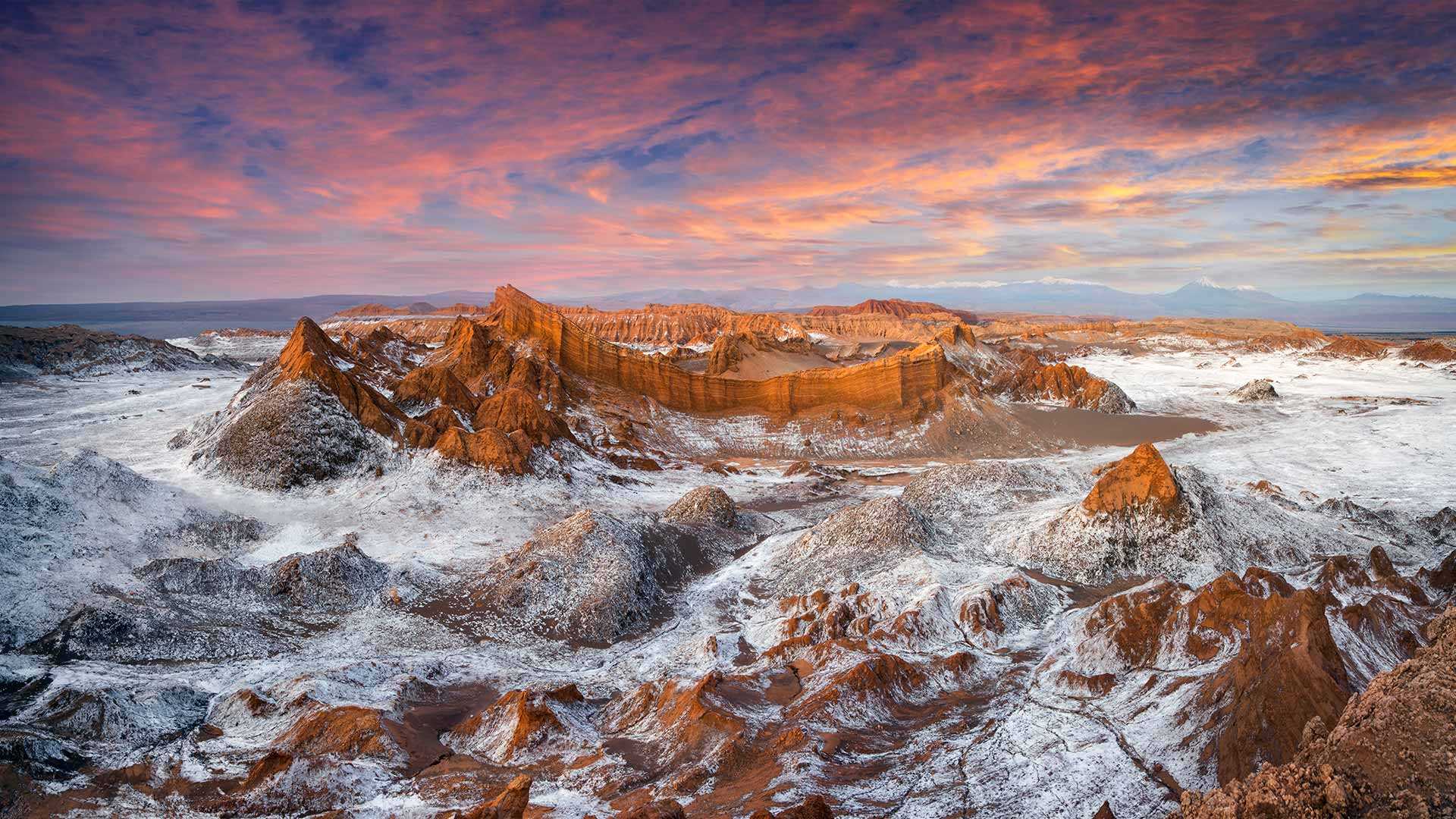
阿卡切斯瞭望台,月亮谷,智利 Achaches lookout, Valley of the Moon, Chile (© Ignacio Palacios/Getty Images)
带我飞向月球 Fly me to the moon
月亮谷,智利
月亮谷位于智利北部的阿塔卡马沙漠,有着令人惊叹的美景。1982年,月亮谷被列为自然保护区,这是因为它拥有极吸引人的、未受破坏的原生环境和奇特的月球地形。关于月亮谷还有一个有趣的知识,那就是这片沙漠已经很多年未下过一滴雨了。
Achaches lookout, Valley of the Moon, Chile
El Valle de la Luna (Valley of the Moon) is located in the Atacama Desert of northern Chile. It has the most breathtaking view from the Achaches lookout. In 1982, Moon valley was declared a nature sanctuary for its stunning, untouched habitat and its peculiar lunar-like terrain. An interesting fact about the Valley of the Moon is that the desert hasn't received a single drop of rain in countless years.
复活节岛上的摩艾石像,智利 Moai statues on Easter Island, Chile (© Karine Aigner/Tandem Stills + Motion)
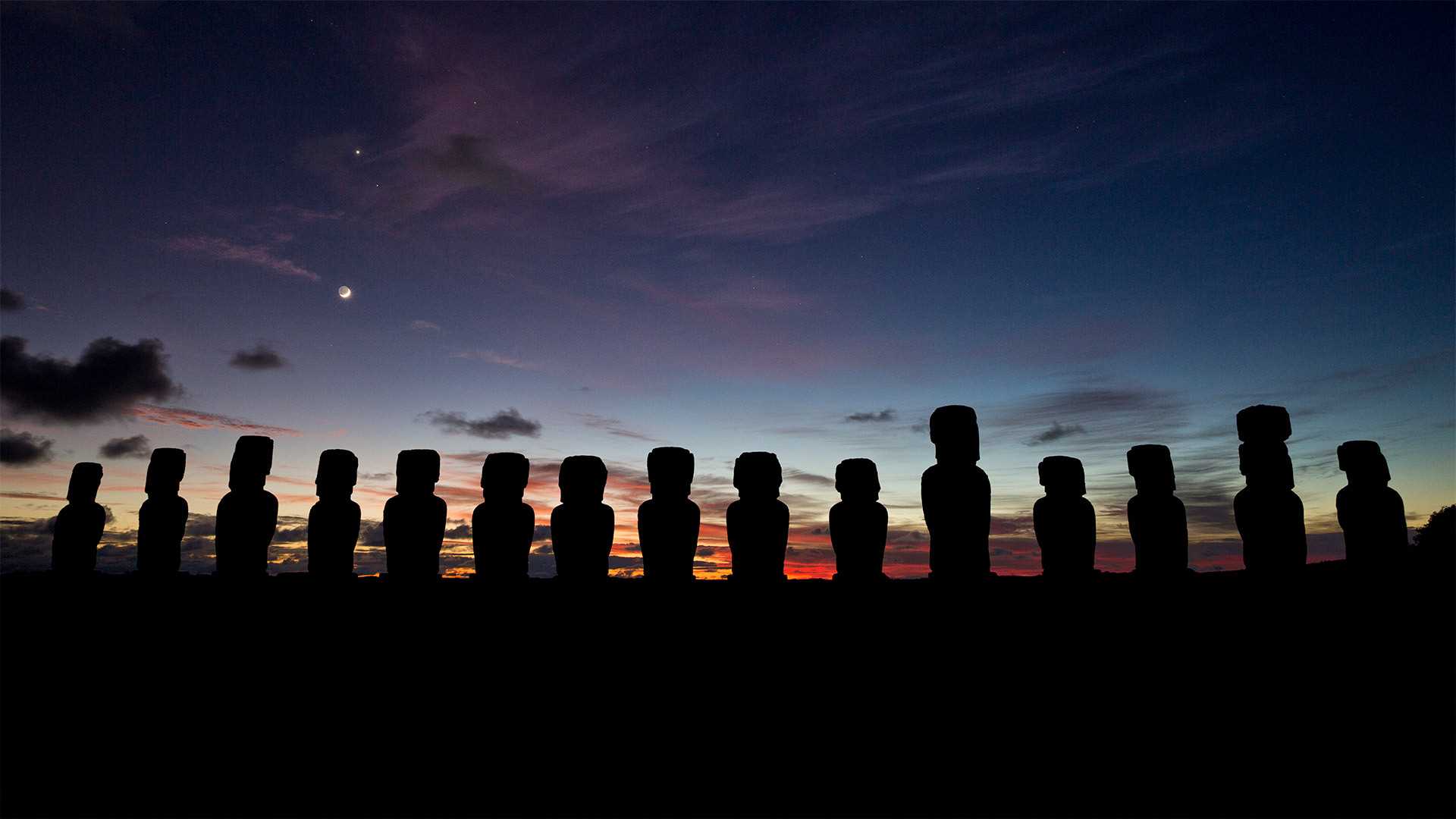
复活节岛上的摩艾石像,智利 Moai statues on Easter Island, Chile (© Karine Aigner/Tandem Stills + Motion)
摩艾石像 Big rocks, big heads
摩艾石像,智利
今天,照片上呈现的是久负盛名的摩艾石像,它位于智利偏远的复活节岛上。这些巨人石像是由拉帕努伊人在1250年到1500年之间用岩石雕刻而成的,全岛共有近1000座石像。考古学家认为,拉帕努伊人用这些石像纪念他们的祖先,并将其视为权力和权威的象征。这些石像里有7座面朝大海,其余石像都是背对着太平洋,面朝内陆看着村庄,仿佛是在保护着拉帕努伊人。
Moai statues on Easter Island, Chile
Today we're looking at something you may have heard about before—the famous Moai statues on Chile's remote Easter Island. These big-headed statues were carved out of solidified volcanic ash by the Rapa Nui people between 1250 and 1500, and there are nearly 1,000 of them on the island. Archaeologists believe they were meant to honor Rapa Nui ancestors and were revered as symbols of power and authority. All but seven of the statues face away from the surrounding Pacific Ocean, and instead look inward toward the villages, as if positioned to watch protectively over the Rapa Nui.
拉西拉ESO天文台上的天文望远镜设备,智利 Swedish antenna at La Silla ESO Observatory, Chile (© Alberto Ghizzi Panizza/Getty Images)
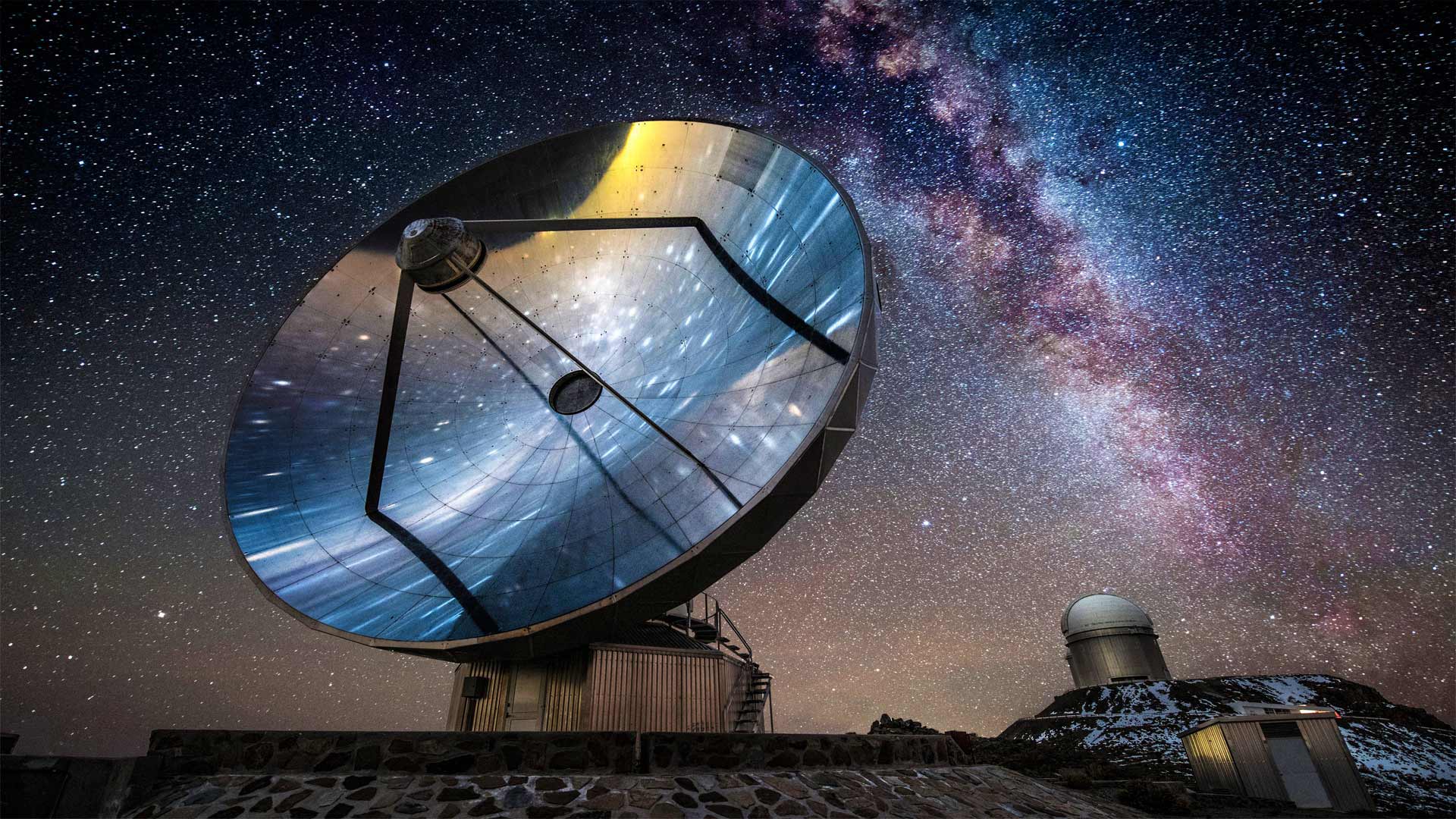
拉西拉ESO天文台上的天文望远镜设备,智利 Swedish antenna at La Silla ESO Observatory, Chile (© Alberto Ghizzi Panizza/Getty Images)
仰望夜空 Eyes on the skies
Astronomy Day
In one of the darkest places on Earth there's a cluster of telescopes that examine the heavens each night, sending detailed information about the celestial bodies they observe to astronomers across the planet. Far from any population centers or light pollution, the Atacama Desert is the world's driest nonpolar desert. It's the perfect place for La Silla Observatory, one of the largest observatories in the Southern Hemisphere, and the first to be used by the European Southern Observatory (ESO), a research organization made up of astronomers from 16 European nations. The first ESO telescope at the La Silla site in Chile began operating in 1966.
And what better place to spend World Astronomy Day? Started in 1973 by Doug Berger, the president of the Astronomical Association of Northern California, Berger's initial intent was to set up various telescopes in busy urban locations so that passersby could enjoy views of the heavens. Since then, the event has expanded and is now sponsored by several organizations associated with astronomy. The springtime Astronomy Day is mirrored by another in the fall between mid-September and mid-October.
天文日
在地球上最黑暗的地方之一,每天晚上都有一组望远镜检查天空,向地球各地的天文学家发送有关他们观察到的天体的详细信息。阿塔卡马沙漠远离任何人口中心或光污染,是世界上最干燥的非极性沙漠。这是南半球最大的天文台之一拉西拉天文台的完美地点,也是欧洲南方天文台(ESO)首次使用的天文台,该研究机构由来自16个欧洲国家的天文学家组成。智利拉希拉基地的第一台ESO望远镜于1966年开始运行。
还有什么地方能更好地度过世界天文日呢?1973年,北加州天文协会主席道格·伯杰(Doug Berger)创立了该望远镜,伯杰最初的意图是在繁忙的城市地点安装各种望远镜,以便路人可以欣赏天空。从那时起,这项活动已经扩大,现在由几个与天文学有关的组织赞助。9月中旬至10月中旬之间的秋季,春季天文学日与另一个天文学日相映成趣。
帕瑞纳天文台的望远镜和星迹,智利阿塔卡马沙漠 Telescopes and star trails at Paranal Observatory, Atacama Desert, Chile (© Matteo Omied/Alamy)
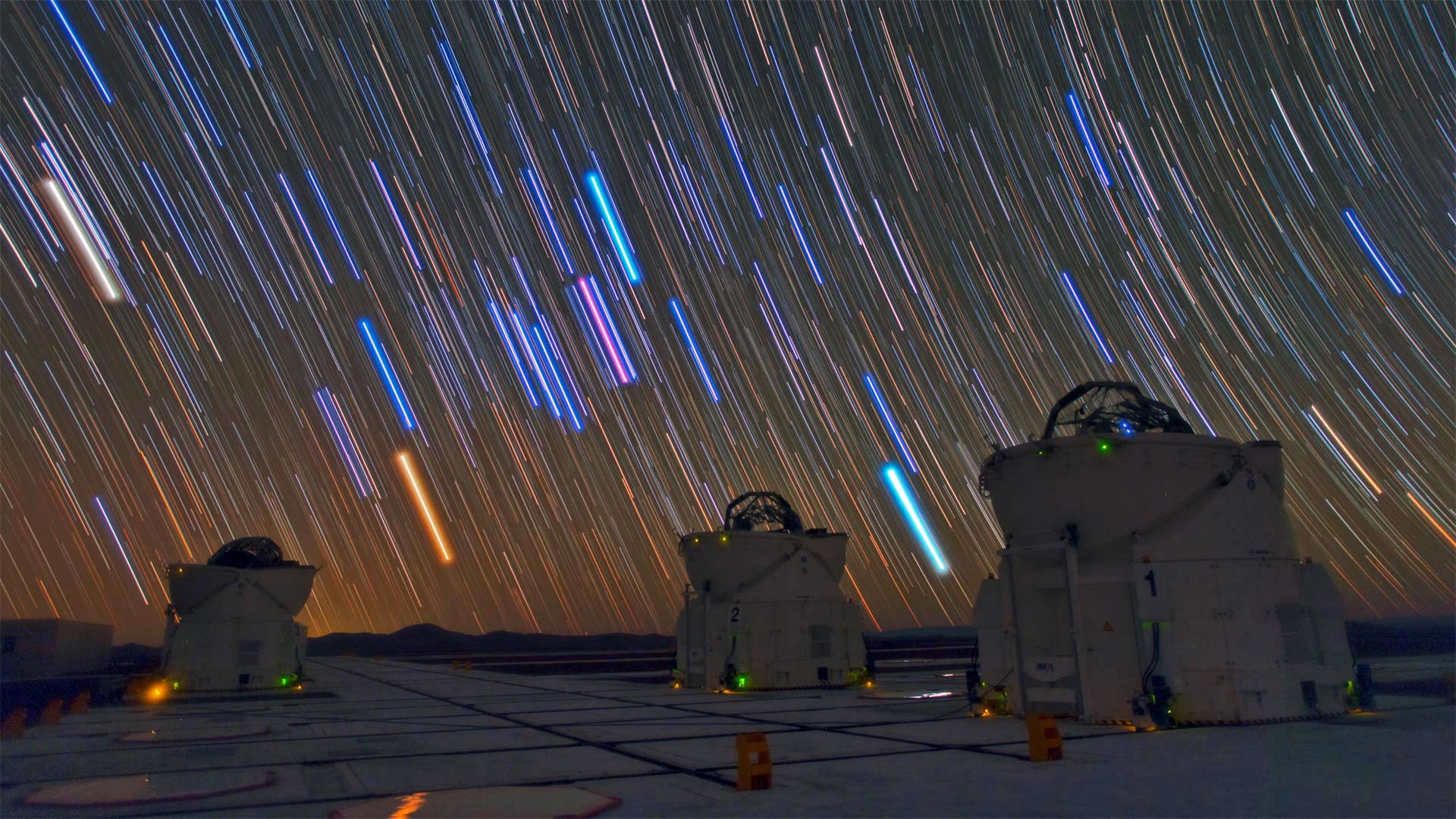
帕瑞纳天文台的望远镜和星迹,智利阿塔卡马沙漠 Telescopes and star trails at Paranal Observatory, Atacama Desert, Chile (© Matteo Omied/Alamy)
Happy Astronomy Day!
No, that's not a downpour of lightsabers—but it's no typical night sky either. Stargazing here at Paranal Observatory, on a mountaintop in Chile's desolate Atacama Desert, you'll get one of the clearest possible naked-eye views of the southern skies. This 'lightsaber' effect comes from the photo's long exposure: What we're seeing is these stars' paths as they track across the night sky due to our planet's rotation. The dazzling colors indicate temperature, from chilly red (5,000-ish degrees Fahrenheit) to balmy blue (temps in the tens of thousands).
What about those structures beneath the starry sky? They're three of the eight telescopes making up the Very Large Telescope, an aptly named project of the European Southern Observatory. Together the telescopes compose photographs of astronomically fine focus: If you were to drive a car on the surface of the moon (which we don't advise trying), the VLT could snap a crystal-clear shot of your headlights.
天文学节快乐!
不,那不是一场光剑雨,但也不是典型的夜空。在智利荒凉的阿塔卡马沙漠的山顶上,你可以用肉眼看到最清晰的南方天空。这种“光剑”效应来自于照片的长时间曝光:我们看到的是由于我们星球的自转,这些恒星在夜空中的轨迹。耀眼的颜色表示温度,从冷红色(5000华氏度)到温和的蓝色(数万华氏度)。
星空下的那些建筑呢?它们是组成超大型望远镜的八个望远镜中的三个,这是欧洲南方天文台的一个恰当命名的项目。这些望远镜一起组成了天文上精细聚焦的照片:如果你在月球表面驾驶一辆汽车(我们不建议你尝试),VLT可以拍下你的头灯的清晰照片。
亚伊马火山与前景中的智利南洋杉,智利孔吉利奥国家公园 Volcano Llaima with Araucaria trees in the foreground, Conguillío National Park, Chile (© Fotografías Jorge León Cabello/Getty Images)
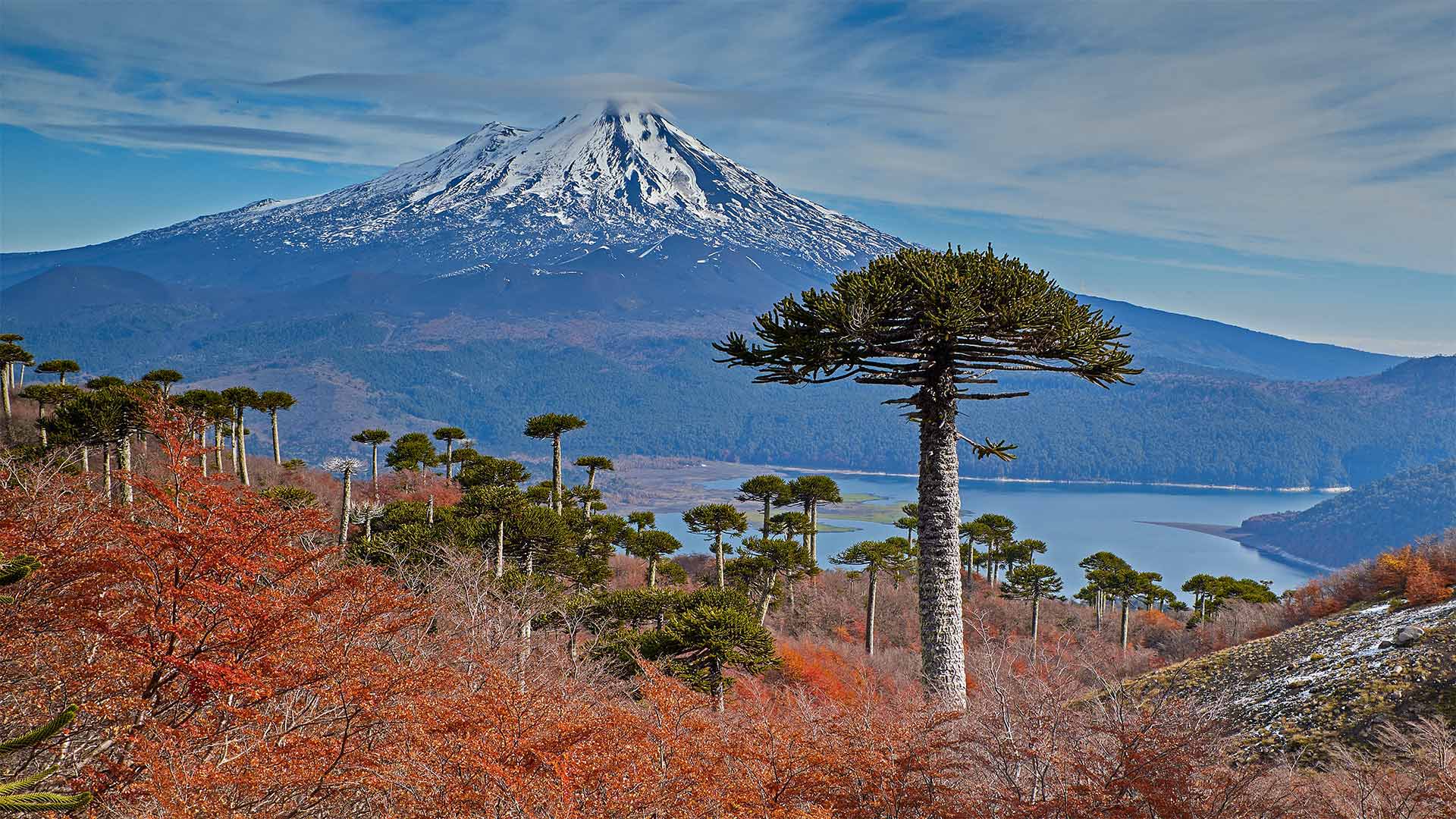
亚伊马火山与前景中的智利南洋杉,智利孔吉利奥国家公园 Volcano Llaima with Araucaria trees in the foreground, Conguillío National Park, Chile (© Fotografías Jorge León Cabello/Getty Images)
Fall for Chile
Autumn in Chile varies widely as one travels from the Atacama Desert in the north more than 2,600 miles south to the tip of Tierra del Fuego. Around halfway between these two extremes you can find Conguillío National Park and the volcano Llaima at Chile's center. In March, at the start of the Southern Hemisphere's autumn, the leaves of the deciduous forest begin to turn color and fall, and the native Chilean pine trees (Araucarias) stand out even more strikingly.
Because of their distinctive appearance and the fact that they thrive in a wide range of climates, the trees became a favorite of botanists in the 19th century, who transported and cultivated them in many temperate climates around the world. The 'monkey puzzle' trees got their common English name in the 1850s when English barrister Charles Austin observed that 'It would be a puzzle for a monkey to climb that.' Even more amazing is that these trees can live over a thousand years and are themselves living fossils, descended from a lineage stretching back 260 million years to the time of the dinosaurs.
爱上智利
智利的秋天变化很大,人们从北部的阿塔卡马沙漠向南行驶2600多英里,到达火地岛的顶端。在这两个极端的中间,你可以看到智利国家公园和智利中心的拉伊马火山。今年3月,南半球秋季伊始,落叶林的树叶开始变色、飘落,智利本土的松树(Araucarias)更加引人注目。
由于其独特的外观和在各种气候条件下茁壮成长的事实,这些树在19世纪成为植物学家的最爱,他们在世界各地的许多温带气候条件下运输和栽培它们。19世纪50年代,英国大律师查尔斯·奥斯汀(Charles Austin)指出,猴子爬上那棵树将是一个谜,于是“猴子拼图”树就有了共同的英文名称。更令人惊奇的是,这些树能活上一千多年,而且本身就是活化石,其世系可追溯到公元前2.6亿年恐龙。
Portrait of poet Pablo Neruda projected on building, Santiago, Chile (© Mario Tellez/Anadolu Agency/Getty Images)
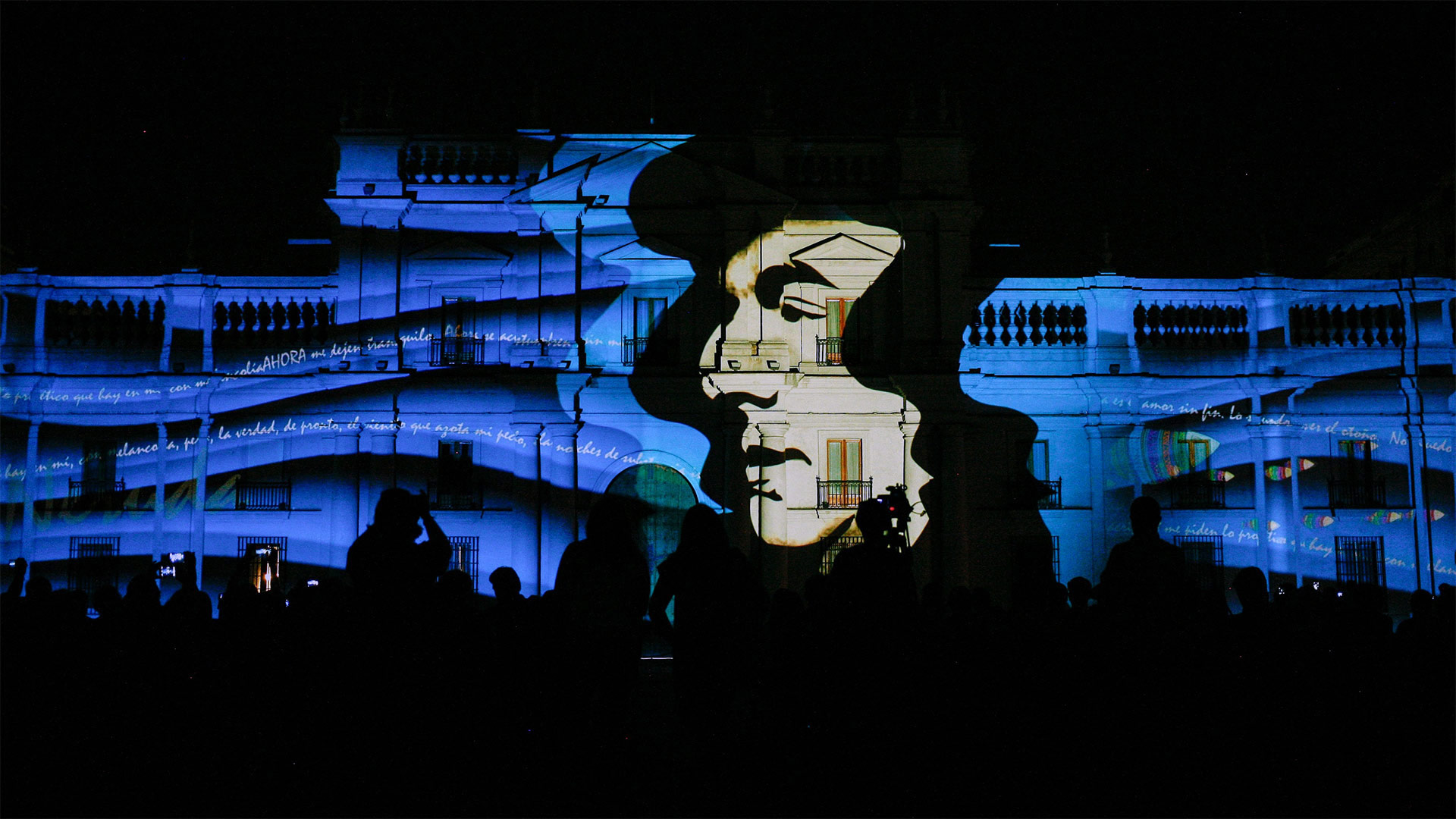
Portrait of poet Pablo Neruda projected on building, Santiago, Chile (© Mario Tellez/Anadolu Agency/Getty Images)
It's World Poetry Day
For World Poetry Day, we're seeing the stylized visage of poet Pablo Neruda projected on a building in his native Chile. World Poetry Day was established by UNESCO to acknowledge 'that individuals, everywhere in the world, share the same questions and feelings.' Neruda, a Nobel laureate generally held up by Chileans as their national poet, made his early mark with famously racy love poetry. But his palette of questions and feelings evolved, expanding into surrealism, epic history, and radical politics. His death in 1973 after a bout with cancer was mourned publicly by Chileans—in defiance of newly installed dictator Augusto Pinochet, whom many Chileans link to Neruda's untimely passing.
For World Poetry Day, UNESCO encourages embracing the tradition of reciting poetry for an audience—so keep your eyes peeled for poetry slams and other gatherings of language lovers sure to take place around the world today. Care to prepare? Brush up on your poetry knowledge with today's quiz.
拉帕努伊国家公园中阿胡汤加里基的摩艾石像,智利复活节岛 Moai statues at Ahu Tongariki in Rapa Nui National Park, Easter Island, Chile (© blickwinkel/Alamy)
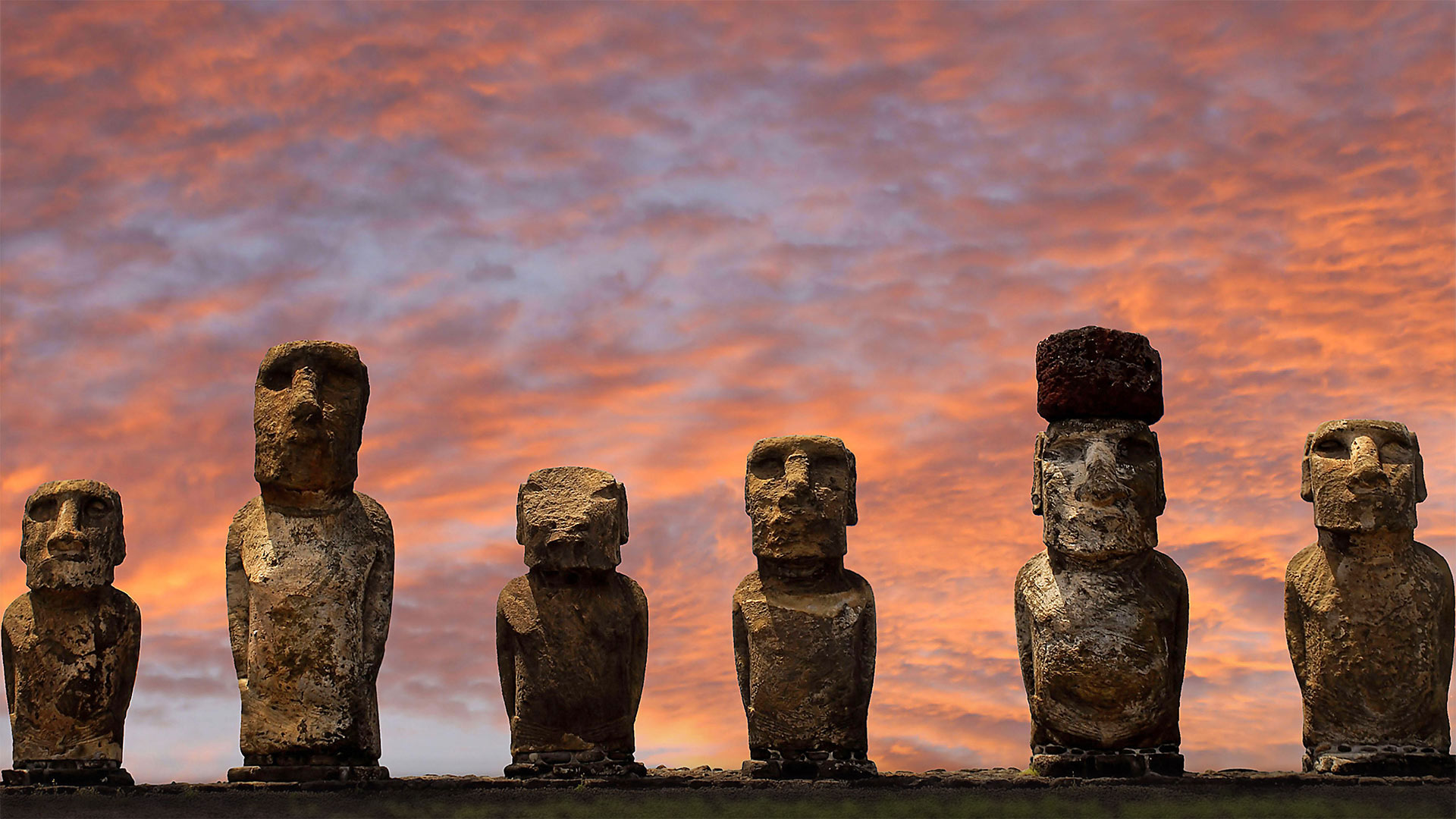
拉帕努伊国家公园中阿胡汤加里基的摩艾石像,智利复活节岛 Moai statues at Ahu Tongariki in Rapa Nui National Park, Easter Island, Chile (© blickwinkel/Alamy)
The 'moai' you know
Roam around the tiny, remote Easter Island and you'll find almost 900 of the stern stone faces called moai. They seem ancient as the pyramids, even a little alien, but they were actually sculpted between 500 and 800 years ago from compacted volcanic ash that's as terrestrial as it comes. You're seeing six of the 15 moai that stand on Ahu Tongariki, the largest ahu (stone platform) on the island. These statues were toppled in the 18th or 19th century along with other moai island-wide for reasons not fully known to scholars, though earthquakes or possible tribal infighting are postulated. The statues were later buried by a tidal wave and lay in ruins until the 1990s when they were excavated and placed back on the ahu.
Though scholars still debate how and why the moai were constructed and moved into place, it's known that they represent the ancestors of the Rapa Nui, an isolated and hardy culture that still celebrates its uniqueness. Visit Easter Island during the first two weeks of February and you'll find yourself in the midst of Tapati Rapa Nui, a festival that revives islander ceremonies of song and dance, as well as sporting events like ocean canoeing, horse racing, and haka pei (high-speed sledding on banana tree trunks).
The Villarrica volcano in Chile on September 2, 2018 (© Cristobal Saavedra Escobar/Reuters)
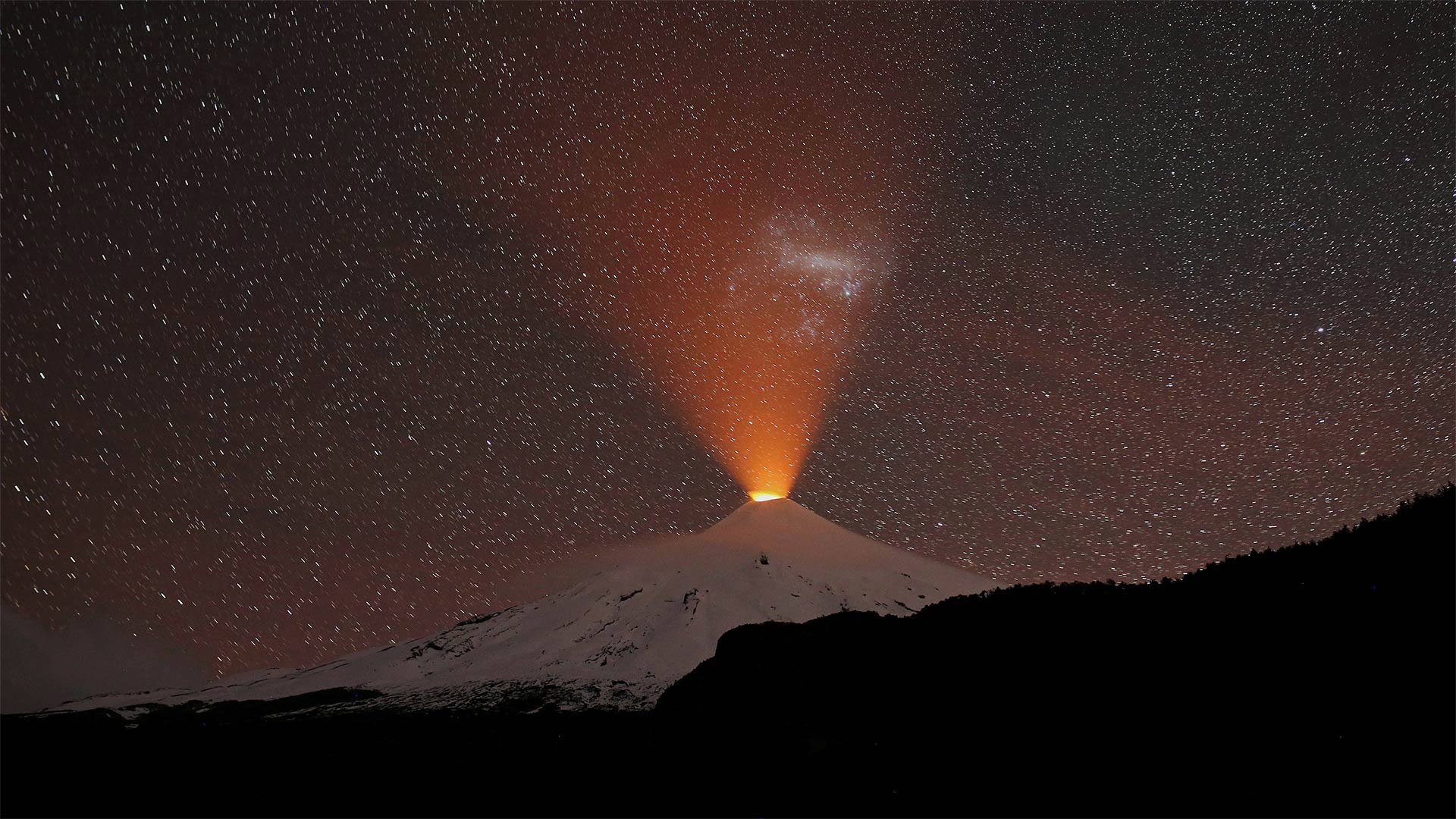
The Villarrica volcano in Chile on September 2, 2018 (© Cristobal Saavedra Escobar/Reuters)
Celebrating Chile's Independence Day
That's the Villarrica volcano providing fireworks for our observance of Chile's Independence Day celebrations—called Fiestas Patrias—taking place September 18 and 19. The second-most active volcano in South America, Villarrica is known to the indigenous Mapuche people as Rucapillán (Devil's House). This photo was taken on September 2, 2018, alarming nearby residents, but it wasn't nearly as destructive as other relatively recent eruptions, like one in 2015 that prompted authorities to evacuate thousands of people.
Chile's Fiestas Patrias take place each year just before the spring equinox in the Southern Hemisphere, so the Independence Day celebrations double as a kind of spring festival. With most schools and workplaces on a weeklong vacation, people observe the holiday by attending rodeos, going to the beach, visiting family, and—above all—indulging in traditional Chilean food and drink. It's said that Chileans gain 10 pound or more during the Fiestas Patrias. Most gorge themselves on empanadas de pino, which are small pastries filled with minced meat, sautéed onions, hard-boiled egg, olives, and sometimes raisins. The empanadas are typically eaten with a variety of grilled meats from barbecue stands called asados. It's all washed down with local red wine or chicha, which in Chile is a sweet, distilled grape- or apple-based beverage that is almost exclusively drunk during the week of Fiestas Patrias celebrations.